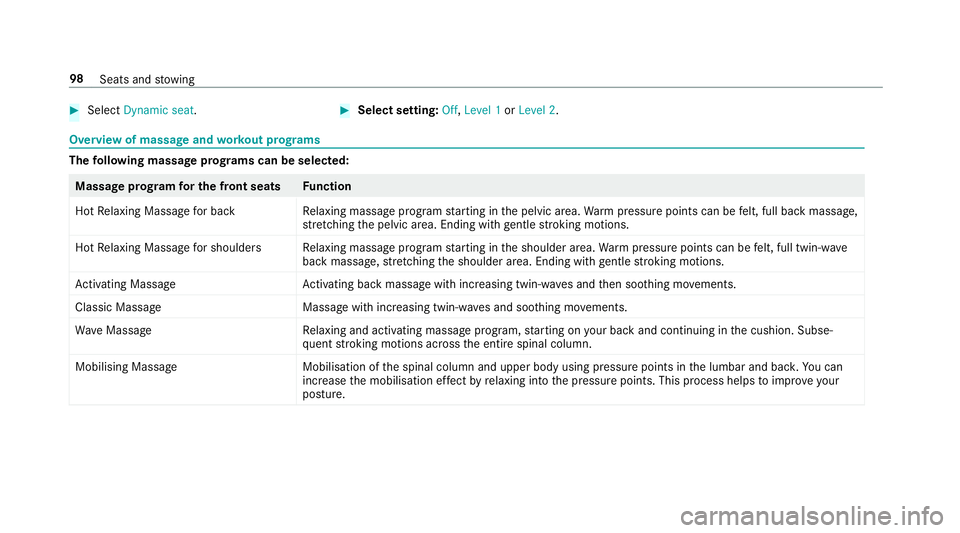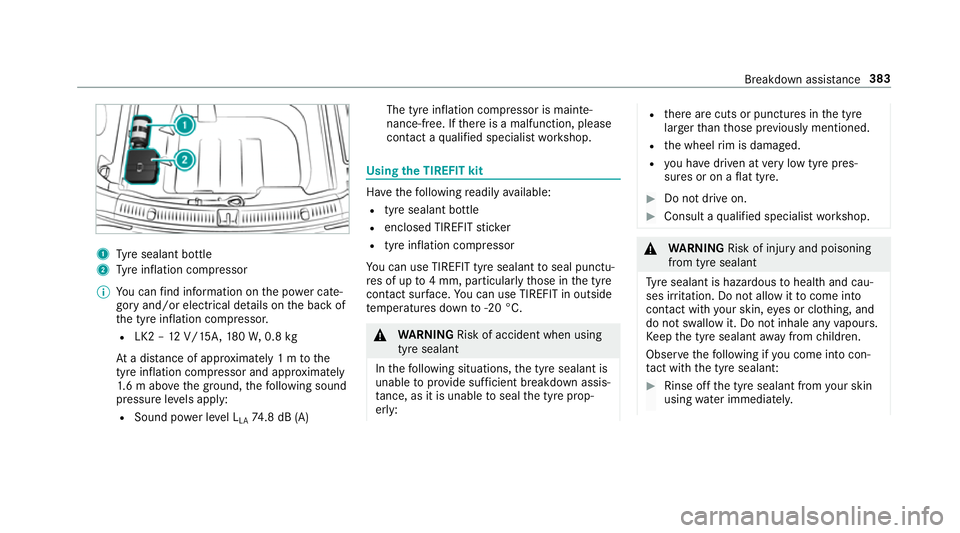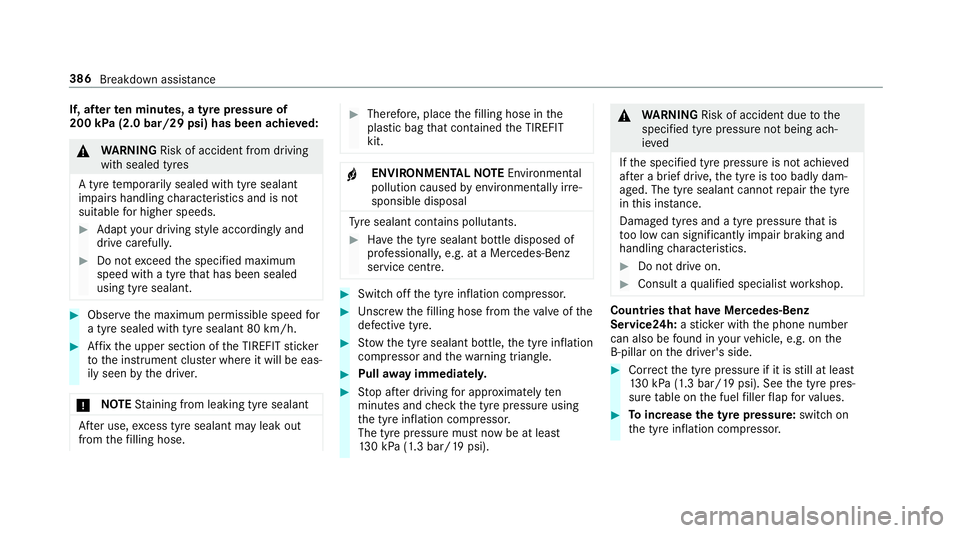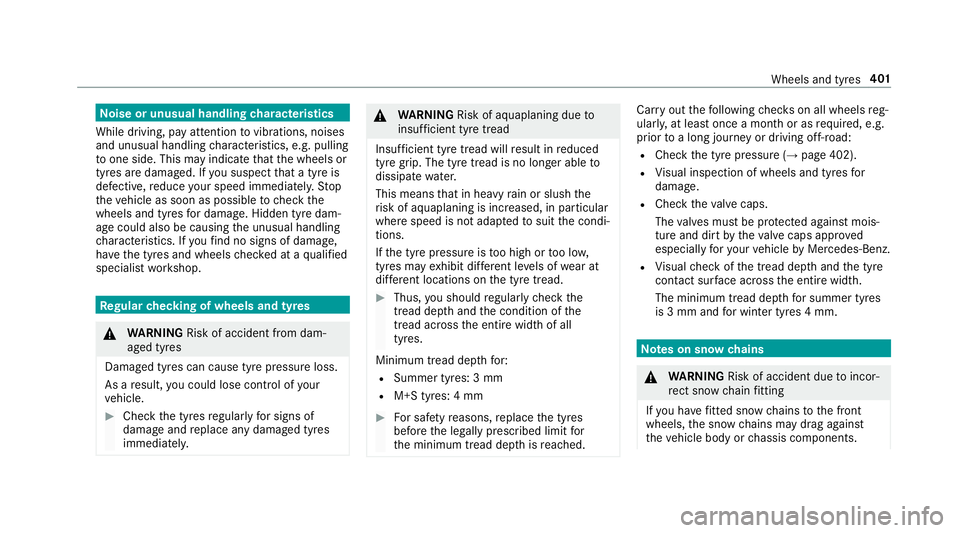2016 MERCEDES-BENZ E-CLASS SALOON tire pressure
[x] Cancel search: tire pressurePage 101 of 557

#
Select Dynamic seat. #
Select setting: Off,Level 1 orLevel 2. Overview of massa
geand workout prog rams The
following massage prog rams can be selected: Massage prog
ram for the front seats Function
Hot Relaxing Massage for bac kR elaxing massage prog ram starting in the pelvic area. Warm pressure points can be felt, full back massage,
st re tching the pelvic area. Ending with gentle stroking motions.
Hot Relaxing Massage for shoulder sR elaxing massage prog ram starting in the shoulder area. Warm pressure points can be felt, full twin-w ave
back massage, stre tching the shoulder area. Ending with gentle stroking motions.
Ac tivating Massa ge Activating ba ckmassa gewith inc reasing twin-w aves and then soo thing mo vements.
Classic Massa ge Massage with increasing twin-w aves and soo thing mo vements.
Wa veMassag eR elaxing and activating massage program, starting on your back and continuing in the cushion. Subse‐
qu ent stro king motions across the entire spinal column.
Mobilising Massag eM obilisation ofthe spinal column and upper body using pressure points in the lumbar and bac k.You can
inc rease the mobilisation ef fect by relaxing into the pressure points. This process helps toimpr oveyour
posture. 98
Seats and stowing
Page 385 of 557

tot
al loss of pressure in one or more tyres. How‐
eve r,th e tyre af fected must not show any clearly
visible damage.
Yo u can recognise MOExtended tyres bythe
MOExtended marking which appears on the side
wa ll of the tyre.
Ve hicles with tyre pressure loss warning sys‐
te m: MOExtended tyres may only be used in
conjunction wi than activated tyre pressure loss
wa rning sy stem.
Ve hicles with tyre pressure monitoring sys‐
te m: MOExtended tyres may only be used in
conjunction wi than activated tyre pressure mon‐
itoring sy stem.
If a pressure loss warning message appears in
th e multifunction display:
R Check the tyres for dama ge
R If driving on, obser vethefo llowing no tes &
WARNING Risk of accident when driving
in run-flat mode
When driving in run-flat mode, the handling
ch aracteristics are impaired. e.g. when cor‐ nering, when accelerating
stronglyand when
braking. #
Do not exceed the maximum permissi‐
ble speed. #
Avoid any abrupt steering and driving
manoeuvres as well as driving over
obs tacles (kerbs, pot holes, off-road).
This applies, in pa rticular, toa loaded
ve hicle. #
Stop driving in run-flat mode if you
notice:
R banging noise
R vehicle vibration
R smoke which smells like rubber
R continuous ESP ®
inter vention
R crac ksin tyre side walls #
After driving in run-flat mode, ha vethe
ri ms checkedby aqu alified specialist
wo rkshop with rega rd totheir fur ther
use. #
The defective tyre must be replaced in
eve rycase. Driving distance possible in li
mp-home mode
af te r the pressure loss warning Load condition Driving distance pos‐
sible in limp-homemode
Pa rtially laden 80 km
Fu lly laden 30 km R
The driving dis tance possible in li mp-home
mode may vary depending on the driving
st yle.
R Maximum permissible speed 80 km/h.
If a tyre has gone flat and cannot be replaced
with an MOEx tended tyre, a standard tyre may
be used as a temp orary measure. TIREFIT kit
storage location The TIREFIT kit is located under
the boot floor. 382
Breakdown assis tance
Page 386 of 557

1
Tyre sealant bottle
2 Tyre inflation compressor
% You can find information on the po wer cate‐
gory and/or electrical de tails on the back of
th e tyre inflation compressor.
R LK2 – 12V/15A, 180W, 0.8 kg
At a dis tance of appr oximately 1 m tothe
tyre inflation compressor and appr oximately
1. 6 m abo vethe ground, thefo llowing sound
pressure le vels apply:
R Sound po wer le vel L
LA 74
.8 dB (A) The tyre inflation compressor is mainte‐
nance-free. If
there is a malfunction, please
conta ct aqualified specialist workshop. Using
the TIREFIT kit Ha
ve thefo llowing readily available:
R tyre sealant bottle
R enclosed TIREFIT sticker
R tyre inflation compressor
Yo u can use TIREFIT tyre sealant toseal punctu‐
re s of up to4 mm, particularly those in the tyre
conta ct surface. You can use TIREFIT in outside
te mp eratures down to-20 °C. &
WARNING Risk of accident when using
tyre sealant
In thefo llowing situations, the tyre sealant is
unable toprov ide suf ficient breakdown assis‐
ta nce, as it is unable toseal the tyre prop‐
erly: R
there are cuts or punctures in the tyre
larger than those pr eviously mentioned.
R the wheel rim is dama ged.
R you ha vedriven at very low tyre pres‐
sures or on a flat tyre. #
Do not drive on. #
Consult a qualified specialist workshop. &
WARNING Risk of inju ryand poisoning
from tyre sealant
Ty re sealant is hazardous tohealth and cau‐
ses ir rita tion. Do not allow it tocome into
contact wi thyour skin, eyes or clo thing, and
do not swallow it. Do not inhale any vapours.
Ke ep the tyre sealant away from children.
Obser vethefo llowing if you come into con‐
ta ct wi th the tyre sealant: #
Rinse off the tyre sealant from your skin
using water immediatel y. Breakdown assis
tance 383
Page 389 of 557

If, af
terte n minutes, a tyre pressure of
200 kPa (2.0 bar/29 psi) has been achie ved: &
WARNING Risk of accident from driving
wi th sealed tyres
A tyre temp orarily sealed with tyre sealant
impairs handling characteristics and is not
suitable for higher speeds. #
Adapt your driving style according lyand
drive carefull y. #
Do not exceed the specified maximum
speed with a tyre that has been sealed
using tyre sealant. #
Obse rveth e maximum permissible speed for
a tyre sealed with tyre sealant 80 km/h. #
Affix th e upper section of the TIREFIT sticker
to the instrument clus ter where it will be eas‐
ily seen bythe driver.
* NO
TEStaining from leaking tyre sealant Af
ter use, excess tyre sealant may leak out
from thefilling hose. #
Therefore, place thefilling hose in the
plastic bag that con tained the TIREFIT
kit. +
ENVIRONMEN
TALNO TEEnvironmental
pollution caused byenvironmen tally ir re‐
sponsible disposal Ty
re sealant contains polluta nts. #
Have the tyre sealant bottle disposed of
professionall y,e.g. at a Mercedes-Benz
service cent re. #
Switch off the tyre inflation compressor. #
Unscr ew thefilling hose from theva lve of the
defective tyre. #
Stow th e tyre sealant bottle, the tyre inflation
compressor and thewa rning triangle. #
Pull away immediatel y. #
Stop af ter driving for appro ximately ten
minutes and check the tyre pressure using
th e tyre inflation compressor.
The tyre pressure must now be at least
13 0 kPa (1.3 bar/19 psi). &
WARNING Risk of accident due tothe
specified tyre pressure not being ach‐
ie ved
If th e specified tyre pressure is not achie ved
af te r a brief drive, the tyre is too badly dam‐
aged. The tyre sealant cannot repair the tyre
in this ins tance.
Dama ged tyres and a tyre pressure that is
to o low can significantly impair braking and
handling characteristics. #
Do not drive on. #
Consult a qualified specialist workshop. Countries
that ha veMercedes-Benz
Service24h: ast icke r with the phone number
can also be found in your vehicle, e.g. on the
B‑pillar on the driver's side. #
Cor rect the tyre pressure if it is still at least
13 0 kPa (1.3 bar/19 psi). See the tyre pres‐
sure table on the fuel filler flap forva lues. #
Toincrease the ty repressure: switch on
th e tyre inflation compressor. 386
Breakdown assis tance
Page 404 of 557

No
ise or unusual handling characteristics
While driving, pay attention tovibrations, noises
and unusual handling characteristics, e.g. pulling
to one side. This may indicate that the wheels or
tyres are damaged. If you suspect that a tyre is
defective, reduce your speed immediatel y.Stop
th eve hicle as soon as possible tocheck the
wheels and tyres for dama ge. Hidden tyre dam‐
age could also be causing the unusual handling
ch aracteristics. If youfind no signs of damage,
ha ve the tyres and wheels checked at a qualified
specialist workshop. Re
gular checking of wheels and ty res&
WARNING Risk of accident from dam‐
aged tyres
Dama ged tyres can cause tyre pressure loss.
As a result, you could lose cont rol of your
ve hicle. #
Check the tyres regularly for signs of
dama geand replace any damaged tyres
immediatel y. &
WARNING Risk of aquaplaning due to
insuf ficient tyre tread
Insu fficient tyre tread will result in reduced
tyre grip. The tyre tread is no longer able to
dissipate water.
This means that in heavy rain or slush the
ri sk of aquaplaning is increased, in particular
where speed is not adap tedto suit the condi‐
tions.
If th e tyre pressure is too high or too lo w,
tyres may exhibit dif fere nt le vels of wear at
dif fere nt locations on the tyre tread. #
Thus, you should regularly check the
tread de pth and the condition of the
tread across the entire width of all
tyres.
Minimum tread dep thfor:
R Summer tyres: 3 mm
R M+S tyres: 4 mm #
For saf etyre asons, replace the tyres
before the legally prescribed limit for
th e minimum tread dep thisreached. Car
ryout thefo llowing checks on all wheels reg‐
ularly, at least once a month or as requ ired, e.g.
prior toa long journey or driving off- road:
R Check the tyre pressure (→ page 402).
R Visual inspection of wheels and tyres for
damage.
R Check theva lve caps.
The valves must be pr otected against mois‐
ture and dirt bytheva lve caps appr oved
especially foryo ur vehicle byMercedes-Benz.
R Visual check of the tread dep thand the tyre
contac t surface across the entire width.
The minimum tread dep thfor summer tyres
is 3 mm and for winter tyres 4 mm. Note
s on snow chains &
WARNING Risk of accident due toincor‐
re ct snow chain fitting
If yo u ha vefitted snow chains tothe front
wheels, the snow chains may drag against
th eve hicle body or chassis components. Wheels and tyres
401
Page 415 of 557

Obser
vethefo llowing when selecting, fitting and
re placing tyres:
R Countr y-specific requirements for tyre
appro valth at define a specific tyre type for
yo ur vehicle.
Fu rthermore, the use of cer tain tyre types in
cer tain regions and areas of operation can
be highly beneficial.
R Only use tyres and wheels of the same type
(summer tyres, winter tyres, MOEx tended
tyres) and the same make.
R Only fit wheels of the same size on one axle
(left and right).
It is only permissible tofit a di fferent wheel
size in theeve nt of a flat tyre in order to
drive tothe specialist workshop.
R Only fit tyres of the cor rect size onto the
wheels.
R Do not make any modifications tothe brake
sy stem, the wheels or the tyres.
The use of shims or brake dust shields is not
permitted and may in validate theve hicle's
ge neral operating pe rmit. R
Vehicles with a tyre pressure monitoring
sy stem: Allfitted wheels mu stbe equipped
with functioning sensors forth e tyre pres‐
sure monitoring sy stem.
R Attemp eratures below 7 °C, use winter tyres
or all-season tyres mar ked M+S for all
wheels.
Wi nter tyres bearing thei snowflake
symbol in addition tothe M+S marking pro‐
vide the best possible grip in wintry road
conditions.
R For M+S tyres, only use tyres with the same
tread.
R Obser vethe maximum permissible speed for
th e M+S tyres fitted.
If th is is below theve hicle's maximum speed,
th is must be indicated in an appropriate label
in the driver's field of vision.
R Run in new tyres at moderate speeds forthe
fi rs t10 0 km.
R Replace the tyres af ter six years at the latest,
re ga rdless of wear. R
When replacing with tyres that do not
fe ature run-flat characteristics: Vehicles
with MOExtended tyres are not equipped
with a TIREFIT kit at thefa ctor y.Equip the
ve hicle with a TIREFIT kit af terre placing with
tyres that do not feature run-flat characteris‐
tics, e.g. winter tyres.
Fo r more information on wheels and tyres, con‐
ta ct a qualified specialist workshop.
Be sure toalso obse rveth efo llowing fur ther
re lated subjects:
R Notes on tyre pressure (→ page 402)
R Tyre pressure table (→ page 403)
R Notes on the emer gency spa rewheel
(→ page 419) Note
s on inter changing wheels &
WARNING Risk of inju rythro ugh dif fer‐
ent wheel sizes
Inter changing the front and rear wheels if the
wheels or tyres ha vediffere nt dimensions 412
Wheels and tyres
Page 546 of 557

St
oring the SIM card PIN ..................... 324
Switching mobile phones ..................... 324
Tr ans ferring the phone book ............... 325
Te lephone number
Dialling (on-board computer) .............. .253
Te lephone operation
see Calls
Te lete xt
Displaying ............................................ 359
Overview ............................................. 358
Te levision
see TV
Te mp erature ............................................ .141
Te xt messages ......................................... 314
Ac tivating/deactivating trans ferring
(telephone module) ............................ .324
Calling a sender .................................. .316
Commands (LINGU ATRO NIC) .............. 265
Composing ........................................... 315
Con figuring thete xt messa ges dis‐
pla yed .................................................. 315
Del eting .............................................. .316
No tes ................................................... 314
Re ad-aloud function ............................ .315 Re
ading ................................................ 315
Re plying ...............................................3 16
Sending ................................................ 315
Through-loading feature
see Seat
Ti e-d owney es .......................................... 11 0
Time Manual time setting ............................. 277
Setting summer time ........................... 277
Setting the time and date automati‐
cally ..................................................... 277
Setting the time zone .......................... 277
Setting the time/date form at .............. 277
TIREFIT kit ................................................ 382
Declaration of Conformity ..................... 25
St orage location ..................................3 82
Using ................................................... 383
TIREFIT kit see Tyre pressure
To ne settings ...........................................3 60
Ad justing the balance/fader ............... 360
Ad justing treble, mid and bass ............ 360
Calling up the sound menu .................. 360
Information .......................................... 360 To
ngue weight ........................................ .436
To ol
see Vehicle tool kit
To pTe ther .................................................. 49
To tal di stance recorder .......................... .249
Displ aying ............................................ 24 9
To uch Control
On-board computer ............................. 24 6
Operating ............................................ 269
Setting the sensitivity .......................... 269
To uchpad
Operating ............................................ 270
Re ading the handwriting recognition
aloud ................................................... 271
Selecting an input language ................. 271
Setting the sensitivity .......................... 271
Switching on/off ................................. 270
To w- aw ay protection
Fu nction ................................................ 88
Switching on/o ff................................... 89
To w- starting ............................................. 397
To wing a trailer
Coupling up/uncoupling a trailer ........ 239 Index
543
Page 548 of 557

Calling up
the menu (CA module) ........ 360
Commands (LINGU ATRO NIC) .............. 264
Displaying telete xt ............................... 359
Displa ysintheTV control menu .......... 355
Fu nction/no tes (audio language,
subtitles) ............................................. 358
Information .......................................... 352
Inserting theCA module ...................... 359
Overview ............................................. 354
Picture settings ................................... 359
Picture settings overview .................... 359
Setting subtitles .................................. 358
Setting the audio language .................. 358
Showing/hiding theTV menu .............. 355
Te lete xt overview ................................. 358
TV channel
Ac tivating/deactivating channel fix ..... 356
Channel fix .......................................... 356
Channel li stove rview .......................... 357
EPG (elect ronic programme guide) ...... 356
Overview of favo urites ........................ .357
Qui cksave ........................................... 357
Selecting from thech annel list ............ 355
Selecting from the control menu ......... 355
Selecting from thefa vo urites .............. 355 Selecting in
the bac kground ................ 356
St oring .................................................3 57
Using a voice tag ................................. 357
Tw o-w ayradio telephone
see Mobile phone
Tw o-w ayradios ........................................ 421
Fr equencies ......................................... 422
No tes on ins tallation ............................ 421
Tr ansmission output (maximum) ........ .422
Ty pe appr oval number (EU) .................... 423
Ty pes of commands (LINGU ATRO NIC) ... 258
Ty re inflation compressor
see TIREFIT kit
Ty re pressure ........................................... 383
Checking (ty repressure monitoring
sy stem) ............................................... 405
No tes .................................................. 402
Re starting the tyre pressure loss
wa rning sy stem ................................... 409
Re starting the tyre pressure monitor‐
ing sy stem ...........................................4 05
Ty re pressure loss warning sy stem
(function) ............................................. 408 Ty
re pressure monitoring sy stem
(function) ............................................. 404
Ty re pressure table .............................. 403
Ty re pressure loss warning sy stem
Fu nction .............................................. 408
Re starting ............................................ 409
Ty re pressure moni toring sy stem
Checking the tyre pressures ................4 05
Fu nction .............................................. 404
Re starting ............................................ 405
Te ch nical da ta..................................... 406
Ty re pressure table ................................. 403
Ty re tread ................................................. 401
Ty re-change tool kit
Overview .............................................. 413
Ty res
Changing .............................................. 414
Changing hub caps .............................. 414
Checking the tyre pressure (tyre
pressure monitoring sy stem) ............... 405
Fitting .................................................. 417
Flat tyre ............................................... 381
MOExtended tyres ............................... 381
Noise ................................................... 401 Index
545